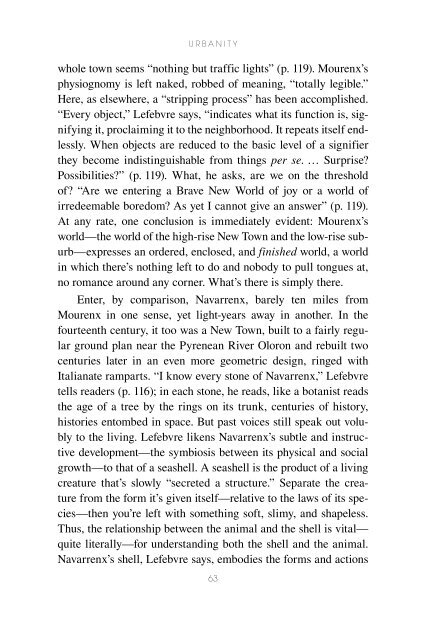Henri Lefebvre: A Critical Introduction - autonomous learning
Henri Lefebvre: A Critical Introduction - autonomous learning
Henri Lefebvre: A Critical Introduction - autonomous learning
You also want an ePaper? Increase the reach of your titles
YUMPU automatically turns print PDFs into web optimized ePapers that Google loves.
U r b a n i t y<br />
whole town seems “nothing but traffic lights” (p. 119). Mourenx’s<br />
physiognomy is left naked, robbed of meaning, “totally legible.”<br />
Here, as elsewhere, a “stripping process” has been accomplished.<br />
“Every object,” <strong>Lefebvre</strong> says, “indicates what its function is, signifying<br />
it, proclaiming it to the neighborhood. It repeats itself endlessly.<br />
When objects are reduced to the basic level of a signifier<br />
they become indistinguishable from things per se. … Surprise?<br />
Possibilities?” (p. 119). What, he asks, are we on the threshold<br />
of? “Are we entering a Brave New World of joy or a world of<br />
irredeemable boredom? As yet I cannot give an answer” (p. 119).<br />
At any rate, one conclusion is immediately evident: Mourenx’s<br />
world—the world of the high-rise New Town and the low-rise suburb—expresses<br />
an ordered, enclosed, and finished world, a world<br />
in which there’s nothing left to do and nobody to pull tongues at,<br />
no romance around any corner. What’s there is simply there.<br />
Enter, by comparison, Navarrenx, barely ten miles from<br />
Mourenx in one sense, yet light-years away in another. In the<br />
fourteenth century, it too was a New Town, built to a fairly regular<br />
ground plan near the Pyrenean River Oloron and rebuilt two<br />
centuries later in an even more geometric design, ringed with<br />
Italianate ramparts. “I know every stone of Navarrenx,” <strong>Lefebvre</strong><br />
tells readers (p. 116); in each stone, he reads, like a botanist reads<br />
the age of a tree by the rings on its trunk, centuries of history,<br />
histories entombed in space. But past voices still speak out volubly<br />
to the living. <strong>Lefebvre</strong> likens Navarrenx’s subtle and instructive<br />
development—the symbiosis between its physical and social<br />
growth—to that of a seashell. A seashell is the product of a living<br />
creature that’s slowly “secreted a structure.” Separate the creature<br />
from the form it’s given itself—relative to the laws of its species—then<br />
you’re left with something soft, slimy, and shapeless.<br />
Thus, the relationship between the animal and the shell is vital—<br />
quite literally—for understanding both the shell and the animal.<br />
Navarrenx’s shell, <strong>Lefebvre</strong> says, embodies the forms and actions<br />
63
















